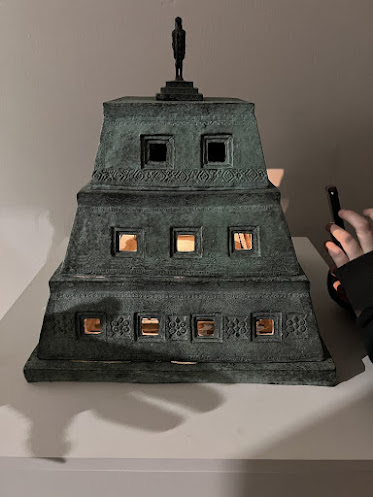Nottingham Lakeside Arts is The University of Nottingham's unique public arts centre and museum presenting an eclectic programme of music, dance, theatre, visual art, special collections and family events all year round. Nottingham Lakeside Arts was established by The University of Nottingham in September 2001, when the Pavilion housing the newly built Djanogly Theatre first opened, adding to the University’s pre-existing arts buildings of the Djanogly Gallery and Djanogly Recital Hall.
She is renowned for her large-scale open-air sculptures of animals and mystical hybrid creatures. In the early 1990s, her reputation was established with monumental outdoor works constructed from twisted wire. Like her friend and supporter, the sculptor Elisabeth Frink, she has also worked in plaster and bronze as well as a plethora of other media including sheet metal and marble.
This exhibition focuses on the artist's smaller-scale sculptures shown alongside works on paper. Some of the bronzes are maquettes: models for much larger pieces. Others were created to be art works in their own right. Drawings and prints may relate directly to sculptures or vice versa or be entirely independent creations. Occupying a middle ground between the two are the wire drawings in which the artist has manipulated a mesh of twisted wire to construct flattened images on the wall. From a distance they resemble large charcoal drawings.
The Ladyhare is a creature born of the artist's imagination. Half-woman, half-hare, she is a recurring character in Ryder's work, appearing either alone or paired with her male counterpart, the Minotaur. Whereas the hare is a creature whose symbolism is deeply rooted in English folklore, the Minotaur has its origins in classical mythology. Picasso's famous representations of this hybrid monster were a direct source of inspiration for the young artist. She speaks of the Ladyhare and Minotaur occupying an ambiguous space between wild nature and orderly human culture.
Other subjects that feature often in Ryder's work - particularly in the large drawings - are her beloved dogs. The last of our galleries is occupied by a large and atmospheric installation. Temple to the 200 Rabbits is a work provoked by the paradox of man's reverence for, and cruel mistreatment of, the animal world.
My favourite piece that I saw created with resin by Ryder was Temple to the 200 Rabbits 1999. This large installation was inspired by two very different experiences. The first took place in the South of France. The positioning of the installations are to represent Ryders inspiration.
Ryder tells how a farmer proudly took her to see the rabbits he was breeding for eating:
"He led me into a dark room with a low ceiling and only one little window with a shaft of sunlight shining through. There in front of me were hundreds of rabbits - some dead, some living, some hopping. The outcome of this experience was that I felt compelled to record it in some way."
In 1995, the artist and her family spent some months in Mexico in a village called Tepoztlan. Rising above the village was a mountain topped by a stone pyramid. This temple, called Teposteko, is dedicated to the Aztec rabbit god of drunkenness and fertility. It was this that provided the title for the work.
The resulting installation - which actually features native hares rather than rabbits - combines her memories of these two contrasting encounters. Subdued lighting and a soundtrack of Morton Feldman's Why Patterns adds an otherworldly atmosphere.
Exhibited alongside the installation is a bronze maquette of the same name. Originally modelled in clay at the Mexican pottery in Cuernavaca, it was cast in bronze on her return to England. The interior of the temple is polished so that the viewer, looking through the windows, has the impression of seeing hundreds of little rabbits.
















